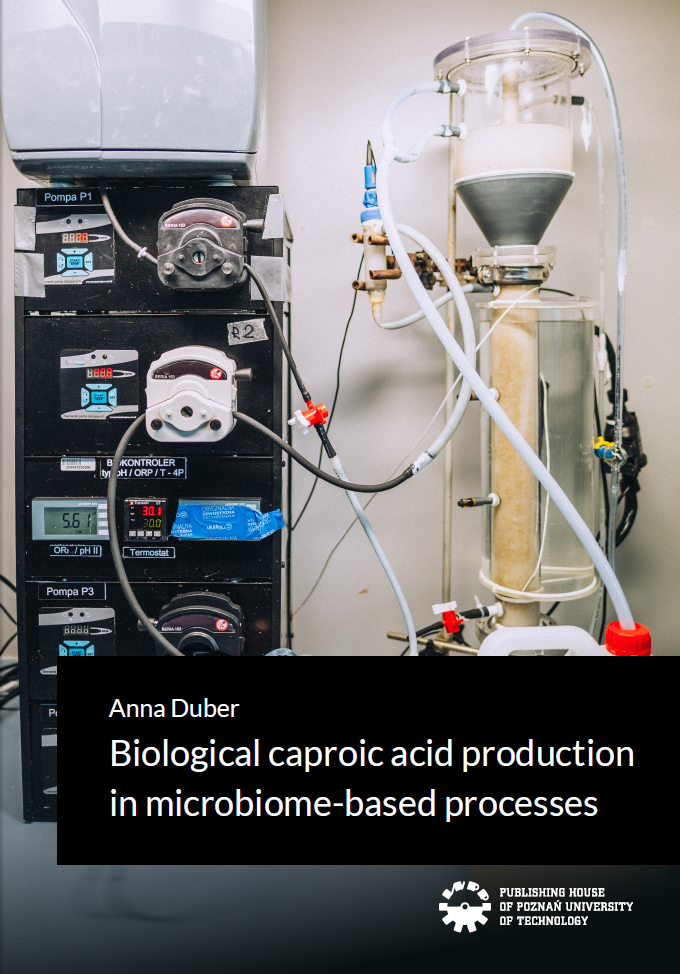Biological caproic acid production in microbiome-based processes
Download Biological caproic acid production in microbiome-based processes

The dissertation consists of two parts. The first one is an introduction that provides the context, main goals of the work, background on the open culture fermentations for the caproic acid production in microbiome-based processes and future outlook. The second part consists of the following publications, which are the basis of this dissertation:
Paper I: Duber, A., Jaroszynski, L., Zagrodnik, R., Chwialkowska, J., Juzwa, W., Ciesielski,
S., Oleskowicz-Popiel, P., 2018. Exploiting the real wastewater potential for resource recovery –
n-caproate production from acid whey, Green Chemistry 20, 3790–3803. https://doi.org/10.1039/C8GC01759j
Impact Factor 9.405, 45 (200) points of MNiSW, individual input: 60%.
Anna Duber conceptualised and conducted the research, performed microbiological analyses, interpreted the results and wrote the manuscript.
Paper II: Duber, A., Zagrodnik, R., Chwialkowska, J., Juzwa, Oleskowicz-Popiel, P., 2020.
Evaluation of the feed composition for an effective medium chain carboxylic acid production in an open culture fermentation, Science of The Total Environment 728, 138814. https://doi.org/10.1016/j.scitotenv.2020.138814
Impact Factor 7.963, 200 points of MNiSW, individual input: 70%.
Anna Duber conceptualised and conducted the research, performed the chromatographic and microbiological analyses, interpreted the results and wrote the manuscript.
Paper III: Duber, A., Zagrodnik, R., Gutowska, N., Łężyk, M., Oleskowicz-Popiel, P. 2022.
Lactate and Ethanol Chain Elongation in the Presence of Lactose: Insight into Product Selectivity and Microbiome Composition. ACS Sustainable Chemistry & Engineering 10, 3407−3416. https://doi.org/10.1021/acssuschemeng.1c05869
Impact Factor 8.198, 140 points of MNiSW, individual input: 75%.
Anna Duber initiated and led the planning of the research, conceptualised and conducted the research, performed the chromatographic and microbiological analyses, interpreted the results and wrote the manuscript.
ISBN 978-83-7775-770-3
eISBN 978-83-7775-769-7
https://doi.org/10.21008/b.978-83-7775-769-7
Permission to use Biological caproic acid production in microbiome-based processes under the terms of the Creative Commons Attribution-Alike 4.0 License (also known as CC-BY-SA), available at https://creativecommons.org/licenses/by-sa/4.0/ or any other language version of this license or any later version of this license published by Creative Commons.
Table of Contents
Abstract 12
List of abbreviations 17
1. Background 19
1.1. Organic waste for bioeconomy 19
1.2. Biological conversion of organic waste 20
1.3. Caproic acid 21
2. Aim of the study 23
3. Material and methods 25
3.1. Continuous processes configuration 26
3.2. Batch processes configuration 28
3.3. Analytical methods 29
3.4. Microbiome analyses 30
3.5. Calculations 31
4. Open (mixed) culture fermentation 33
5. Process strategies and operational factors 39
5.1. Competing metabolic pathways 39
5.1.1. Methanogenic activity 39
5.1.2. Chain elongation 40
5.1.3. Other metabolic pathways 41
5.2. Fermentation parameters 42
5.3. Product toxicity 43
5.4. Substrate composition 43
6. Reactor microbiome characterisation 47
7. Conclusions 51
8. Final remarks and future outlook 53
9. References 55
Paper I 63
Paper II 93
Paper III 119
List of scientific achievements 122

